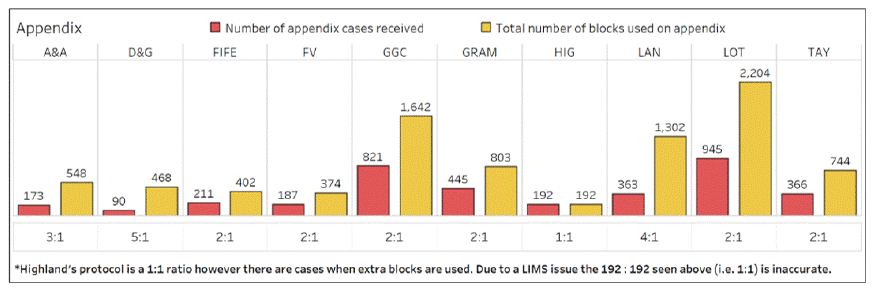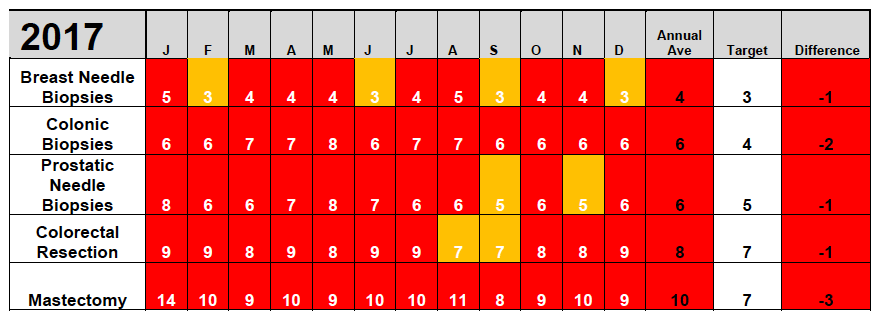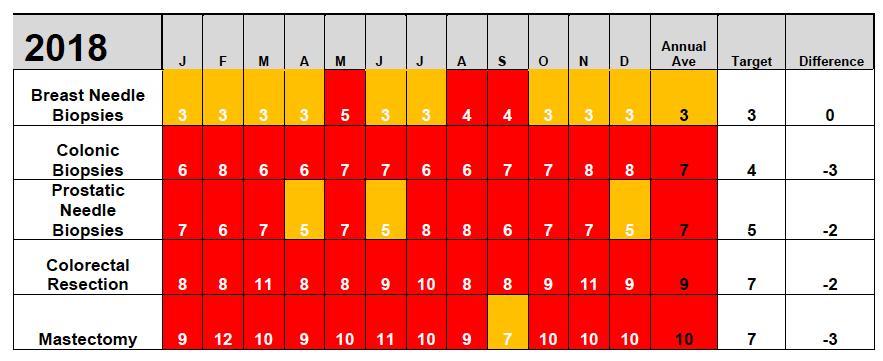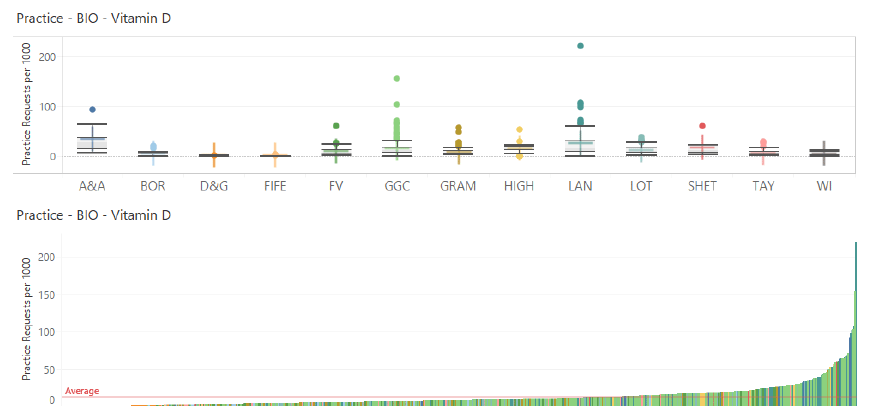Demand optimisation in laboratory medicine: phase two report
Phase two activity report produced by the Scottish National Demand Optimisation Group (NDOG).
6 Quality Improvement
6.1 Background
Quality Improvement initiatives remain an important mechanism for improving laboratory services across NHS Scotland. Many such initiatives begin their development within individual NHS Boards and are then showcased as examples for others to also implement. Initiatives increasingly involve collaboration or interaction directly with clinical services. It is the latter clinical end of the patient pathway where benefits in terms of better outcomes, increased efficiency or financial savings can be realised as a result of changes in laboratory function or test use.
Historically, laboratories have struggled to implement change due to silo budgeting. Flexibility around this is very important to allow laboratories to implement the initial changes around test use or availability that can then have much wider knock on benefits across the clinical interface.
The examples below of Quality Improvement initiatives provide the opportunity for other Laboratory Services to consider implementation of similar concepts. This is not always straightforward due to local differences in NHS Board structure, clinical interfaces and IT functionality. The existence of the National Managed Diagnostic Networks allows such initiatives to be presented, discussed and considered for further roll out.
Multidisciplinary Initiatives
6.1.1 NHS Tayside- The intelligent Liver Function Testing pathway (iLFT)
Liver disease is now the fifth most common cause of death overall in the UK, and the third most common cause of death in people under 65 years of age.
Although liver function tests (LFT) alone may indicate liver disease, the results are commonly abnormal, as detailed by the Abnormal Liver Function Investigations Evaluation (ALFIE), performed in NHS Tayside between 1989 and 2003. Around 1.3% of patients with abnormal LFT results go on to develop significant liver disease. Additional investigations of abnormal test results on initial samples provide an opportunity to diagnose and manage liver disease earlier and ultimately significantly impact mortality by reducing the number presenting with late or end-stage liver disease.
The object of the iLFT pathway study was to reduce the morbidity, mortality and costs associated with late-presenting liver disease. To achieve this, iLFT aimed: -
- to increase the diagnosis of liver disease, especially at an earlier stage
- to improve the appropriateness of referral to secondary care
- to ensure that all patients with significant disease, or those where significant liver disease cannot be excluded, are appropriately referred to the liver clinic for assessment.
- to remain cost-effective
The pilot study used an automated, algorithm-based system that further investigated abnormal LFTs on initial blood samples received from primary care. It was designed using a multi-disciplinary approach incorporating hepatology, biochemistry, immunology, virology, haematology and laboratory IT services.
To date, iLFT became fully operational across NHS Tayside’s primary care service in August 2018 and has identified that 70% of patients are suitable for ongoing investigation and management in primary care, helping to improve the appropriateness of referral to hepatology services.
Due to the increase in diagnosis and follow-up there is also likely to be an increase in referral to liver services, at least in the short-term. However, these referrals are all necessary, and patients are receiving appropriate and relevant prior investigations, resulting in earlier intervention and improved patient and hospital outcomes.
An additional unforeseen positive outcome has been that the multi-disciplinary iLFT aetiology screen has identified other clinical diagnoses alongside the common alcohol-related liver disease and non-alcoholic fatty liver disease, including hepatitis infections which now have a higher pick-up rate through iLFT than the current screening program.
The success of iLFT has led to the Scottish Government identifying the pathway as eligible for adoption across the whole of NHS Scotland as part of its Modern Outpatient Programme. The Tayside iLFT group are currently collaborating with other NHS Scotland NHS Boards to assist with the implementation of iLFT within their laboratories and primary care services. Additionally, several Clinical Commissioning Groups (CCGs) from NHS England have expressed keen interest in setting up iLFT in their own areas. Furthermore, negotiation is underway with a multinational diagnostics company to consider the addition of iLFT to their global portfolio of services.
Specialty Specific Quality Initiatives
Pathology
6.1.2 NHS Lanarkshire - Audit of sampling appendectomy specimens for histopathological assessment
Appendices are usually removed due to appendicitis or accompanying other operations. Appropriate sections depend on the indication for appendectomy, however, there is no specific advice given by the Royal College of Pathologists (RCPath) on the minimum number of blocks that should be taken.
Following data submission by SPAN on the number of blocks taken per appendiceal case, there was variation in number of blocks taken across the labs in Scotland (Figure 10). The object of this study was to analyse if appropriate numbers of tissue blocks were taken at NHS Lanarkshire in relation to the RCPath recommendations.
Figure 10: Number of appendix cases and ratio of blocks used per NHS Board during financial year 2017-2018

A review audit was carried out collecting the demographic and pathological data of all patients who underwent appendectomy at NHS Lanarkshire between 1st January and 30th June 2017. The data revealed that the number of blocks taken depended upon the indication of appendectomy and the block number taken was commensurate with the adequate diagnosis of the cases submitted.
Following the audit, NHS Lanarkshire will move to a new LIMS in 2019 and there is a plan to provide two cassettes for standard sampling of the appendix. Further cassettes could be added if required by the dissectors.
6.1.3 NHS Forth Valley- Reduction of histology specimen turnaround times
There is currently a National shortage of Consultant Pathologists as highlighted by the Royal College of Pathologists and Cancer Research UK,. The issues highlighted in the papers clearly demonstrated that local turnaround times for Histopathology for NHS FV did not meet local turnaround time targets.
Table 2: NHS Forth Valley histology reporting turnaround times in 2017

In order to improve turnaround times and improve compliance to cancer wait targets, NHS Forth Valley embarked on 2 separate projects. This included training of BMS to carry out specimen dissection and the implementation of a voice recognition system for diagnostic reporting. This was due to the largest bottlenecks in complying with turnaround times being attributed to the reporting process.
The first change that NHS FV embarked on was an initiative to train BMS staff to become proficient in performing dissections for category B, C, and D specimens whilst completing the IBMS Diploma of Expert Practice in Specimen Dissection. This would release consultant histopathologists to tackle reducing histology specimen turnaround times.
To date, there has been an improvement in turnaround times for breast needle biopsies (Table 3). However, this project is ongoing and the true impact will not be fully realised until all 3 trainee BMS staff can perform specimen dissection independently.
Table 3: NHS Forth Valley histology reporting turnaround times in 2018

The second initiative included the implementation of a voice recognition system for diagnostic reporting in order to release administrative capacity and improve quality by reducing in transcription errors. It is anticipated this would also improve turnaround times and cancer waiting times by replacing dictation software to voice recognition software for diagnostic reporting.
This project is still in its infancy with no results to date as voice recognition has not been fully implemented yet due to delays in training.
Biochemistry
6.1.4 Scotland - Reduction in Vitamin D testing
The number of test requests for Vitamin D is continually increasing with significant variation in testing across geographical areas and between practices. If not addressed the increasing numbers will impact on the efficiency and sustainability of biochemistry laboratory services within Scotland. The initiative aims to promote standardisation of practise across Scotland, through promotion and adoption of the Vitamin D guideline developed and ratified by the network.
Data collected from the Atlas of Variation from 2017 demonstrated that GG&C and Lanarkshire have the greatest variation in test requesting of Vitamin D across their GP practices, with Lanarkshire requesting almost double the average across Scotland (Mean- 13.2, Lanarkshire 24.7)
Figure 11: Practice requests of Vitamin D per NHS Board

To tackle the variation, SCBN have produced and endorsed guidance on Vitamin D testing and the practices with the highest variability have been approached to discuss change ideas and utilise the practise to trial the initial PDSA cycles.
To date, the Vitamin D guidance has been issued in Lothian and changes have been made to some of the GP order comms systems to reinforce when it is appropriate to request Vitamin D. There are no formal results reported as yet.
Microbiology and Virology
6.1.5 NHS Fife - Reduction of urine samples sent to Microbiology laboratories for analysis
In general, as a first step, patients with a UTI are given empirical antibiotics which are sufficient for treatment in most cases. In some practices, a urine sample is also sent to the laboratory. This is unnecessary as treatment has already begun in the form of antibiotics. Therefore, many samples are unnecessarily analysed, causing excessive workload that could otherwise be alleviated.
This study aims to reduce the number of unnecessary urine samples and reduce the burden on the laboratories that process and report these samples by 10%. This will also reduce the number of patients prescribed antibiotics unnecessarily and reduce the associated paperwork.
Information stating the new guidelines for urine samples was distributed to all GP practices in NHS Fife and a rejection procedure complying with the current guidelines set up in the laboratories. Short reports were produced stating the reason for the rejection, and sent to the requestor.
Baseline data collected 3 months prior to onset of the project showed that 12,319 samples were processed between 1/6/18/-31/08/18. Of these: -
| Negative | 69.3% |
|---|---|
| Positive | 28.1% |
| Rejected | 2.6% |
To date, a final report has not been completed however there was an estimated 15% reduction in numbers of samples. This achieved its target reduction and has resulted in reduced staff time and consumable costs.
6.1.6 NHS Ayrshire & Arran and NHS Dumfries & Galloway - Reduction of High Vaginal Swabs (HVS) sent to Microbiology laboratories for analysis
The number of HVS samples received from the community is unfeasibly high (In 2017, NHS Ayrshire & Arran - 12,333 samples, Dumfries & Galloway- 6,135) and it is felt that there is actually no requirement for some of these samples to be sent to the laboratories. It is anticipated that simple tests performed within the GP practice will help to triage samples and treatment for some of these samples can be given without sending the samples to Microbiology.
This study aims to reduce the number of swabs by 10% by the end of the year. This will be done by ensuring only appropriate swabs are taken and sent to labs, thereby reducing the burden to process and report these samples. In addition, it aims to reduce the number of patients who may be receiving unnecessary antibiotics, further reducing the overall burden on NHS services.
A protocol has been made available with a flow chart for users in measuring vaginal pH. Depending on the pH level a decision can be made about a probable diagnosis and the guidance will help to determine whether swabs are required to be sent to Microbiology. This protocol has been implemented in NHS Fife where they have seen a significant drop in the number of samples received; this reduction has been sustained over a number of years.
In order to measure the outcome, the number of HVS samples coming into the department will be monitored over a period of six months. In addition, monthly checks will be made and recorded and frequent engagement with involved practices will help to ensure compliance.
This project is expected to commence in 2020.
6.1.7 NHS Lothian - Reduction of leg ulcer swabs sent to Microbiology laboratories for analysis
In general, leg ulcer care is mainly provided in the community by nurses. As part of routine care, community nurses will swab the ulcers and send these to labs for analysis. In 2017, NHS Lothian received 23,142 samples, yet the majority did not grow significant bacteria but may have still been prescribed antibiotics unnecessarily. This indicates that, in some cases, there is actually no requirement for these samples to be sent to the laboratories. Instead many may be managed effectively by community nurses.
This study aims to reduce the number of swabs by 10% by the end of the year. This will be done by ensuring only appropriate swabs are taken and sent to labs, thereby reducing the burden to process and report these samples. In addition, it aims to reduce the number of patients who may be receiving unnecessary antibiotics, further reducing the overall burden on NHS services.
A protocol has been made available to provide guidance in the management of leg ulcers. This protocol allows for staging the infection and detailing when swabs should be sent to the laboratory.
This project is expected to commence in 2020.
Haematology
6.1.8 Scotland - Agreed B12 Standardised Diagnostic Testing Pathway
Previous work by the short life Haematology working group (SLHWG) identified a wide variance in the testing of B12, Folate and Ferritin across Scotland covering issues including terms of test availability, variable retesting intervals and further reflex. This led to a petition submitted to the Scottish Parliament by the Pernicious Anaemia Society to raise the issues associated with B12.
Forming consensus testing guidelines would standardise anaemia investigations, especially B12 investigations, as there are already British Society of Haematology (BSH) investigation guidelines available. It was expected a standardised anaemia pathway with emphasis on the B12 diagnostic pathway would result in reduced variation across Scotland for patients and appropriate access for patients to reflex test investigations that follow the BSH guidelines.
The SLHWG collected data from across Scotland on the availability of anaemia testing, minimal retesting intervals, reportable units and further reflex tests that are available. Through a consensus approach, the SLHWG then analysed the data and developed guidelines for users with recommended reporting unit and minimal retesting intervals.
Following approval, these guidelines will be made available widely to referrers with online access via the newly launched HaTS network website and linked to the Atlas of Variation.
Immunology
6.1.9 NHS Grampian- Rationalisation of rheumatoid arthritis serology CCP vs RF
Although joint pain is a common clinical detail in requests to immunology labs from both primary and secondary care, rheumatoid arthritis (RA) is a relatively rare condition with a specific set of presenting features.
In order to assess the likelihood of a patient having rheumatoid arthritis, IgM Rheumatoid factor (Rf) has been used as the serological test. However, it has limited value with moderate clinical specificity (70-75%). The alternative serological test, anti-cyclic citrullinated peptide (CCP) antibodies, is a more clinically specific test (96%) and should minimise false positive RA serology currently found with Rf, particularly in primary care.
The new requesting protocol has been running in NHS Tayside since 2007, limiting CCP requests to approximately 1000 per annum. This protocol has identified the expected number of new RA patients per annum in Tayside given clinical sensitivity of the assay and incidence of disease. However, the Tayside project only has anecdotal evidence from Rheumatology that it has reduced the numbers of inappropriate referrals to out-patient clinics.
To date NHS Grampian has implemented the same protocols as the NHS Tayside process and has rolled it out to a limited number of primary care practices as a pilot before full implementation.
This trial is ongoing and there is no formal data as yet.
Genetics/Molecular Pathology consortia
6.1.10 Scotland - Development of an online eligibility calculator for access to Familial Hypercholesterolaemia (FH) genetic testing
Referral numbers for genetic testing in Familial Hypercholesterolaemia (FH) continue to grow each year with a concomitant decrease in mutation detection rate. This is considered due to the increase in awareness of FH combined with the low specificity of the current eligibility criteria. In house data demonstrated an increase in numbers of referred samples and a decreasing detection rate, resulting in a doubling of cost/mutation positive cases detected.
An online eligibility calculator was predicted to help combat the observed decreasing mutation detection rates in patients referred for genetic testing by increasing the likelihood that those patients selected have FH. It was also predicted this will result in an increase in cost effectiveness.
This project is still in its infancy, with the eligibility calculator currently in development in consultation with IT team.
6.1.11 Laboratory Genetics, Queen Elizabeth University Hospital, Glasgow- Review of Chimerism Service Strategy
In recent years, the service for allogenic bone marrow transplants was transferred to GG&C without consultation of the Genetics laboratory that carry out the chimerism testing. The transfer led to such a large increase in the workload that the laboratory struggled to cope and, in turn led to a failure rate of ~25%. The workload was then further compounded by the introduction of new guidelines for monitoring post-transplant.
An audit reviewing the existing strategy, including the failure rate and the reasons for failures was undertaken and an automated methodology for chimerism testing was developed. This allowed the laboratory to cope with the increase in demand for the test, while also reducing the failure rate.
The change from a manual to an automated protocol following robust validation resulted in an improved test success rate, a reduction in staff processing time of ~50% and the ability to absorb the increased workload with no additional reagent costs.
The new automated test is now fully implemented in GG&C.
6.1.12 Scottish Genetics Consortium Laboratories (Aberdeen, Dundee, Edinburgh, Glasgow) - DPYD Genotyping Pilot
5-Fluorouracil (5-FU) and capecitabine (CAP) are among the most frequently prescribed anticancer drugs used in the treatment of a range of cancer types. Although these treatments are generally well tolerated, ~5-10% of patients treated will suffer severe adverse drug reactions, which can result in hospitalisation (including intensive care unit (ICU) stays) and may even be lethal. These drugs are inactivated in the liver by the enzyme dihydropyrimidine dehydrogenase (DPD). However, specific variants in the DPYD gene can lead to decreased DPD activity which can result in an increased risk of severe side effects and potentially lethal toxicity in patients treated with regular drug doses.
In order to identify patients with DPD deficiency, a pilot study performing DPYD Genotyping on patients prior to commencing treatment is in progress. Data collection is ongoing and will be collated at the end of the pilot period but it is expected to demonstrate a decrease in the number of patients with severe adverse drug reaction including lethal toxicity.
Contact
Email: CNOD_Admin@gov.scot
There is a problem
Thanks for your feedback